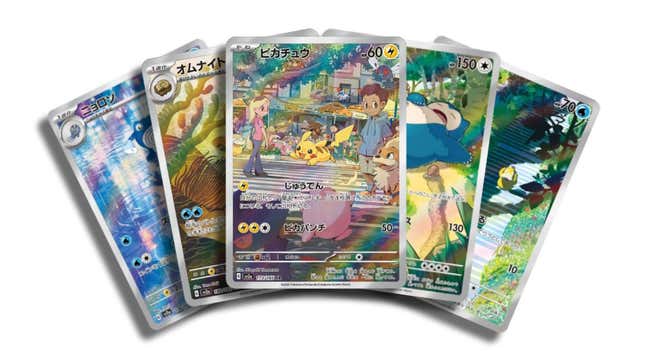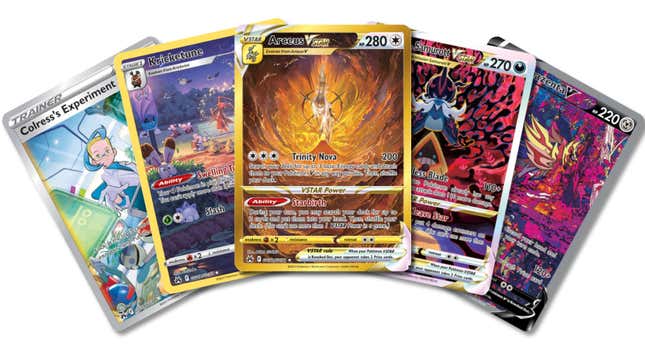When it comes to buying Pokémon trading card packs, there’s pretty much one thing that people care about the most: pull rates. What are the chances of getting a special card in any given foil-wrapped packet? And with early 2023’s Crown Zenith set, they suddenly got a whole lot better. Then, come the Scarlet & Violet era, they’ve gone and gotten a whole lot worse.
Pull rates have always varied, and the extremes have more often have existed in the imagination of customers, rather than the hard stats of any given set. However, when it came to the final collection from the three-year-long Sword & Shield (SWSH) era, Crown Zenith, the improvements were unambiguous. Suddenly your chances of pulling a full-art or better went from perhaps one in four packs, to one in two. In fact, it often felt harder to find a pack that featured only bulk than one with something collectible. And it was glorious.
Gambling or Gamboling
Buying shiny cardboard is an inherently silly pursuit, and only a fool enters into the process with the hope of making a profit. The stats simply don’t work out that way, with the resale market itself balanced by the relative availability of a particular card. In other words, to chance upon a fantastically expensive card, you’re statistically going to have to spend more than you’ll benefit. Sure, someone gets lucky, but it’s folly to work on the assumption that it’s going to be you. Think: lotteries. To approach any TCG this way is to interpret it as gambling, and that works out about as well as any other form of the addictive and potentially life-ruining activity.
Instead, the sensible approach to any collectible card game is to buy the cards if you intend to play the game. A pack of Pokémon cards that contains “only bulk” is suddenly a wad of useful tools if you’re trying to develop a new 6o-card battle deck, where otherwise dismissed trainer cards can become the most essential finds in the wrapper. For those trying to complete a collection, fill a binder for that set, it also changes the value of the regular cards as something you want to be pulling. Getting the more valuable cards becomes something achieved through the essential trading aspect of the hobby. Or if you’re much more sensible, waiting a few months for the prices to collapse, and then picking up the missing cards at shows or online.

A holo in every pack
But none of this makes it any less frustrating to watch your 8-year-old spend $4 of their scant pocket money only to open ten bland, ubiquitous cards. It highlights just how much the gambling aspect overshadows everything, no matter how healthily you try to approach the game. So when Crown Zenith came along, a set designed to be a last hurrah for SWSH, celebrating the Galar region and all our adventures within, things felt really different.
Unlike other sets that had fobbed customers off with, “But there’s a holo in every pack!” Crown Zenith and its Galarian Gallery started handing out the big, pretty cards like candy, and it was both a pleasure to collect and play. Come the release of Scarlet & Violet (SV) in March, the stakes had been raised, and hopes were high that this new attitude would continue. But it has not.
The first set, simply called Scarlet & Violet, made some big changes. For years previously, each pack contained ten cards, one of which would be at least a reverse holo (the whole card expect the picture is shiny). You would also get a “rare,” but this was more often not a holo, just a regular card that was printed less often than the rest. But with SV, the promised cards “improved.” Every pack now contains two reverse holos (or better), and one guaranteed regular holo (where the card is matt, but the image is shiny). So that’s better, right? You’re guaranteed a holo and two reverse holos. So yay?
Well, no, because in introducing full-art cards some years back, the TCG immediately devalued holos into being pretty unexceptional. The tiny image just has a bit of foil on it—big whoop when you could instead have received a beautifully illustrated card where the image stretches top to bottom, with astonishingly intricate and gorgeous drawings. And with SV, a guaranteed holo just represents the lack of the card a person really wanted.
The raw data
In fact, the actual data for pull rates is out there to prove the difference. TCG Player does the hard work for every set, and the difference is stark. The chances of pulling an Ultra Rare or better in Crown Zenith? 49%. And for Scarlet & Violet? 30%.
Gosh, this is all so complicated though. Because if they guaranteed a full-art, then would full-arts become bland? Would people be upset they didn’t receive a Special Illustration Rare if they were certain of an Ultra Rare? The scarcity is such a vital part of the process, and the balance must be nightmarish to manage.
Obviously The Pokémon Company wants people to buy as many packs as possible, because they’re a corporation that strives to make money. So its motivation will always be to balance the numbers in such a way that sells the most product. However, in my experience, and that of many others I’ve spoken to, the more generous the pull rates, the more likely we are to buy more packs.
Anecdotally, I’ve spent an embarrassing amount of money on Crown Zenith (the first set I’ve set out to fully collect), but have no desire to spend another penny on the current Paldea Evolved set. (And, yeah, I already spent far more pennies than most, buying two ETBs and a booster box, so over $200—but, um, it’s a business expense so I justify it to myself on a tax basis…) Like SV, Paldea Evolved (PE) has been just grim for pulls in the wake of Crown Zenith, despite the set boasting ludicrous numbers of amazing full art cards. And that final SWSH set has only made it worse for TPC by its months-long run of new products since January this year, overshadowing the new era by being just a far more enjoying set to buy.

Will Pokémon 151 be any better?
With Obsidian Flames and Pokémon 151 due in August and September respectively, my excitement for new sets has rapidly waned. Why get hyped by all the astounding full-art cards we see in Japan, and know are heading our way, when we already know it’ll be vastly cheaper to pick them up on Cardmarket or wherever in the weeks following? It’d be quite mad to buy Paldea Evolved right now in the hope of pulling the stunning Orthworm Illustration Rare, when I could buy it right now for less than the price of a single pack of the set.
If I’m in my favorite card shop and I see I can pick up three packs of PE for £12, or two packs of Crown Zenith for the same, my money is always going to the latter. Even if I don’t pull a card we still need for our binder, the chances are so high that we’ll get a dupe we can trade for something we’re after.
That’s just not a feeling I’ve gotten since SV’s era began. I’m obviously keen to keep an eye on 151, to see if something special can happen there too (like Crown Zenith, it’s a special set with no booster boxes), but my hopes aren’t high. How can they be, after Paldea Evolved, with its most astonishing numbers of beautiful full art cards, so few of which we’ve pulled in over 50 packs?

While I don’t have the data to prove the trend, certainly from my own experience the more generous a set, the more of my money I want to spend on it. And the relative “generosity” of Crown Zenith has cast a long shadow over the cards that have come out during and since. Going back to the incessant disappointment of sets like Silver Tempest and Darkness Ablaze seems such a colossally bad decision. Three out of every four packs being a dud is just miserable. And the big mistake The Pokémon Company made was showing us how much better it could be.























